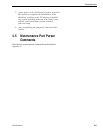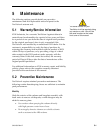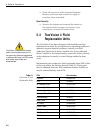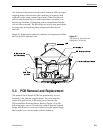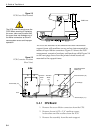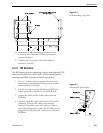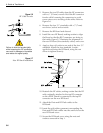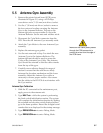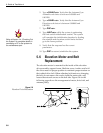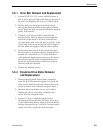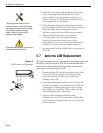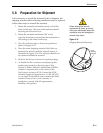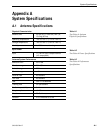
5.5 Antenna Gyro Assembly
1. Remove the printed circuit board (PCB) cover,
illustrated in Figure 5-2, using a #2 Phillips
screwdriver and a
3
⁄8" (10 mm) nut driver/socket.
2. Use the
3
⁄8" (10 mm) nut driver/socket to remove
the four nuts and washers securing the Antenna
Gyro to the Antenna Reflector. The nut on the
bottom right also secures another P-clip to the
Antenna Reflector. Set the nuts and washers aside.
3. Disconnect the 7-pin Molex connector from the
PCB. Place the old Antenna Gyro assembly aside.
4. Attach the 7-pin Molex to the new Antenna Gyro
assembly.
5. Replace the antenna gyro gasket.
6. Use the nuts removed in Step 2 to attach the new
Antenna Gyro to the Antenna Reflector. The
bottom right nut should be used to secure the
P-clip on the Antenna Gyro Cable. The Antenna
Gyro should be oriented so that the cable extends
from the top of the gyro.
7. Carefully move reflector through its range of
motion to ensure that the cable moves freely
between the elevation mechanism and the lower
assembly. Adjust the Antenna Gyro cable as
necessary to ensure proper motion. Also ensure
that the cables to the RF PCB do not interfere with
the Gyro motion.
Antenna Gyro Calibration
1. With the PC connected to the maintenance port,
apply power to the antenna unit.
2. Type
HALT<cr> while the system is performing
the limit switch initialization routine. The system
will complete the initialization function by finding
the azimuth and elevation switch limits and then
go to the home position. Record the 8-digital serial
number that was displayed in the startup message.
3. Type
DEBUGON<cr> to enter Debug Mode.
4. Type
DEBUGON<cr> to enter Debug Mode.
5-7
Maintenance
54-0150 Rev. D
Make sure the cable jacket passes
through the PCB access slot to
protect the wires from the edge of
the PCB frame.



